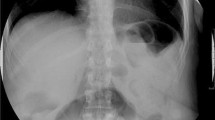Abstract
Background
Over the past 20 years, there has been an ongoing discussion about the importance of gastric pouch size as a key factor influencing weight loss after bariatric surgery. This analysis aimed to determine the relationship between initial gastric pouch size and excess weight loss (EWL) after laparoscopic Roux-en-Y gastric bypass (LRYGB).
Methods
Between August 2002 and March 2005, 320 LRYGB were performed at Yale New Haven Hospital. The patients’ demographics were entered into a longitudinal, prospective database. Upper gastrointestinal series were routinely performed on postoperative day 1. Pouch size was measured as area (cm2) on an anteroposterior radiograph at maximum pouch distention. Linear regression analysis was performed to determine the association between pouch size and weight loss at 6 and 12 months postoperatively. Adjustments were made for age, gender, and preoperative body mass index (BMI).
Results
The mean age of the patients was 41.2 years. Of the 320 study patients, 261 were women (81.6%) and 59 were men (18.4%). The mean preoperative BMI was 51.1 kg/m2; the mean 6-month EWL was 50.5%; the mean 12-month EWL was 62.5%; and the mean pouch size was 63.9 cm2. A statistically significant, negative correlation between pouch size and EWL was found at 6 months (β = –0.241; p < 0.01) and at 12 months (β = –0.302; p < 0.02). The findings show that male gender (β = 0.147; p < 0.04) and preoperative BMI (β = 0.190; p < 0.01) are positively correlated with pouch size.
Conclusion
The analysis demonstrates that initial gastric pouch size is not the only significant component for successful weight loss after LRYGB. Male gender and increased preoperative BMI were identified as factors predicting pouch size. Efforts to standardize small pouch size for all patients seems important to the success of surgical therapy for morbid obesity.









Similar content being viewed by others
References
(1983) 1983 metropolitan height and weight tables. Stat Bull Metrop Life Found 64: 3–9
(1996) Health Insurance Portability and Accountability Act of 1996. Public Law 104–191. US Statut Large 110: 1936–2103
Alder RL, Terry BE (1977) Measurement and standardization of the gastric pouch in gastric bypass. Surg Gynecol Obstet 144: 762–763
Andersen T, Pedersen BH (1984) Pouch volume, stoma diameter, and clinical outcome after gastroplasty for morbid obesity: a prospective study. Scand J Gastroenterol 19: 643–649
Flanagan L (1996) Measurement of functional pouch volume following the gastric bypass procedure. Obes Surg 6: 38–43
Forsell P (1996) Pouch volume, stoma diameter, and weight loss in Swedish adjustable gastric banding (SAGB). Obes Surg 6: 468–473
Forsell P, Hellers G, Laveskog U, Westman L (1996) Validation of pouch size measurement following the Swedish adjustable gastric banding using endoscopy, MRI and barium swallow. Obes Surg 6: 463–467
Fried M, Peskova M (1996) Does laparoscopic gastric banding demand sophisticated measurement devices? Obes Surg 6: 336–340
Halverson JD, Koehler RE (1981) Gastric bypass: analysis of weight loss and factors determining success. Surgery 90: 446–455
Hedenbro JL, Frederiksen SG (2002) Fully stapled gastric bypass with isolated pouch and terminal anastomosis: 1–3 year results. Obes Surg 12: 546–550
Hornberger HR (1976) Gastric bypass. Am J Surg 131: 415–418
Kuzmak LI, Burak E (1993) Pouch enlargement: myth or reality? Impressions from serial upper gastrointestinal series in silicone gastric banding patients. Obes Surg 3: 57–62
Mason EE (1981) Surgical treatment of obesity. Philadelphia, Saunders
Mason EE, Ito C (1967) Gastric bypass in obesity. Surg Clin North Am 47: 1345–1351
Muller MK, Wildi S, Scholz T, Clavien PA, Weber M (2005) Laparoscopic pouch resizing and redo of gastrojejunal anastomosis for pouch dilatation following gastric bypass. Obes Surg 15: 1089–1095
Naslund E, Backman L, Granstrom L, Stockeld D (1995) Does the size of the upper pouch affect weight loss after vertical banded gastroplasty. Obes Surg 5: 378–381
Reinhold RB (1982) Critical analysis of long term weight loss following gastric bypass. Surg Gynecol Obstet 155: 385–394
Salmon PA (1986) Failure of gastroplasty pouch and stoma size to correlate with postoperative weight loss. Can J Surg 29: 60–63
Sorrell VF (1981) Progress in gastric surgery for morbid obesity. N Z Med J 94: 369–371
Author information
Authors and Affiliations
Corresponding author
Rights and permissions
About this article
Cite this article
Roberts, K., Duffy, A., Kaufman, J. et al. Size matters: gastric pouch size correlates with weight loss after laparoscopic Roux-en-Y gastric bypass. Surg Endosc 21, 1397–1402 (2007). https://doi.org/10.1007/s00464-007-9232-x
Received:
Revised:
Accepted:
Published:
Issue Date:
DOI: https://doi.org/10.1007/s00464-007-9232-x




